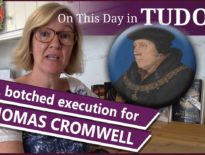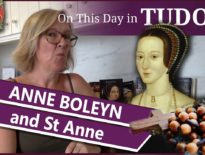On this day in Tudor history, 27th July 1593, Roman Catholic priest and martyr, Blessed William Davies, was hanged, drawn and quartered at Beaumaris Castle on the Island of Anglesey.
You may not have heard of William Davies, but he is believed to have been involved in the printing of “Y Drych Christianogawl”, or The Christian Mirror, an important early Welsh Catholic book and the first book to be printed on Welsh soil, while he was hiding in cave!
Find out more about Davies, how he came to be hiding in a cave in North Wales, and why he was executed, in today's talk.
Article on William Davies - https://www.thecatholicuniverse.com/pdf/daviesbook.pdf
Also on this day in Tudor history, 27th July 1588, Robert Dudley, Earl of Leicester, wrote to his queen with an invitation. He was intent on keeping the queen, the woman he loved, out of harm's way. What was this invitation? Well, you can find out more in last year’s video:
Also on this day in history:
- 1534 – Murder of John Alen, Archbishop of Dublin, in Artane. Alen, his chaplains and servants, were murdered by the men of Thomas Fitzgerald, Baron Offaly, after their ship ran aground near Clontarf and they were taken prisoner. He was buried in a pauper's grave.
- 1550 – Baptism of George Whetstone, writer, at St Lawrence, Old Jewry. His works included “The Rocke of Regarde”, “The Honorable Reputation of a Soldier”, “Heptameron of Civill Discourses” and the two-part play “ Promos and Cassandra”, which was a source for Shakespeare's “Measure to Measure”.
- 1553 – Edward VI's former tutor and principal secretary, Sir John Cheke, was sent to the Tower of London on 27/28th July for his part in putting Lady Jane Grey on the throne. He was released in spring 1554.
- 1578 – Death of Jane Lumley (née Fitzalan), Lady Lumley, translator, at Arundel Place in London. She was buried at St Clement Danes, the Strand, but later moved to a tomb in Cheam, Surrey. Jane is known as the first person to translate Euripides's “Iphigeneia at Aulis” into English, and she also translated various orations of Isocrates from Greek to Latin. Her work can be found in the British Library.
- 1622 – Death of Thomas Knyvett, Baron Knyvett and Gentleman of the Bedchamber to Queen Elizabeth I and James I, at his home in King Street, Westminster. He was buried in Stanwell Church in Middlesex.
Transcript:
On this day in Tudor history, 27th July 1593, Roman Catholic priest and martyr, Blessed William Davies, was hanged, drawn and quartered at Beaumaris Castle on the Island of Anglesey.
But who was Davies and why was he executed?
Let me give you a few facts about this Welshman…
• We don’t know Davies’s precise birthdate but it was probably around 1556.
• He came from Croes-yn-Eirias, a hamlet to the west of Colwyn Bay, in North Wales.
• A William Davies studied at St Edmund’s Hall, Oxford, from 1575 and graduated in 1578, but we don’t know for sure whether it was this William Davies.
• In April 1582, he entered the Jesuit seminary at Reims in France, where he was ordained as a priest by Cardinal Guise on the eve of Passion Sunday in April 1585, the same year that Elizabeth I’s government brought in its act against Jesuits and seminary priests, making it treason for a Jesuit priest to be in England. Davies was then sent to England on a mission to convert people to the old ways, i.e. the Catholic faith.
• Davies chose to back to his his home territory in North Wales, which came under English rule. There, he joined forces with local dignatory Robert ap Hugh, or Robert Pugh, and resided at his house, Plas Penrhyn, and joined a local community of recusants. In 1586, Davies, Pugh and their fellow recusants were forced into hiding, finding refuge in caves in the cliffs of the Little Orme headland. It is not known what happened to make them move, but their move did coincide with the death of Sir Henry Sidney, Lord President of the Council in the Marches, who was alleged to have had Catholic sympathies. Following his death, the council were commanded to take action against Catholic gatherings and those celebrating the Mass.
• While the recusants were hiding in the caves, they built a printing press and it is believed that Davies and Pugh were among those involved in the printing of “Y Drych Christianogawl”, or The Christian Mirror, an important early Welsh Catholic book and the first book to be printed on Welsh soil. The book dealt with the Catholic teaching on death, the day of judgement, hell and heaven. It was printed as a pocket book so that it could be carried and hidden easily.
• Davies was arrested at Holyhead in March 1591 by Foulk Thomas. He was with four young men whom he was planning on escorting to Ireland for them to travel on to Valladolid in Spain to become seminary priests. They were also arrested.
• Davies was taken to Beaumaris Castle where he was interrogated in the presence of Hugh Bellot, bishop of Bangor. Davies eventually confessed to his missionary work but would not name names. He was put into solitary confinement in a dungeon in the castle for a month before he was allowed to talk to fellow Catholics and celebrate Mass with them, and he was also allowed visits from Protestants who wanted to debate with him.
• Robert Pugh, who had managed to avoid arrest, wanted to help Davies escape, but Davies wouldn’t.
• At the next Anglesey Assizes, Davies was found guilty of treason, but he was not sentenced as it was hoped that he could be persuaded to recant his Catholic faith. He was sent to Ludlow to be examined by the Council of the Marches, but he would not turn away from his faith and he was imprisoned in Bewdley for a time, before being sent back to Beaumaris, where he spent his last six months ministering to his fellow Catholic prisoners and praying.
• The summer assizes of 1593 sentenced him to die as a traitor.
• On this day in history, 27th July 1593, Davies was drawn to the gallows within Beaumaris Castle’s walls. There, he prayed on his knees before climbing the scaffold and saying ““This island (Anglesey) was called in the old time the dark island, the which name it never better deserved than at thispresent. But I beseech God that the blood which I am brought hither innocently to shed, may give a light unto it of that faith which it hath received above a thousand years agone.” He then took the noose, kissed it, placed it around his neck and said “Thy yoke, O Lord, is sweet and Thy burden light.” Davies was then hanged, fortunately for him until he was dead rather than being cut down alive, and then he was disembowelled, beheaded and quartered. According to an article by Joseph Kelly, “The head was set on top of his prison cell, two of his quarters were hung in Beaumaris Castle, one in Conwy Castle, and the fourth at Caerwys”.
• In 1909, a chapel was erected to his memory at Beaumaris, and he was beatified in November 1987 by Pope John Paul II as one of the 85 martyrs of England and Wales.



Leave a Reply